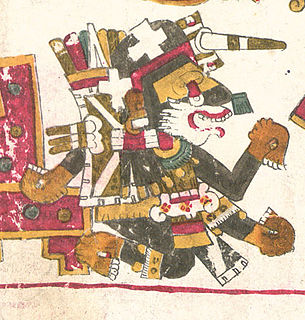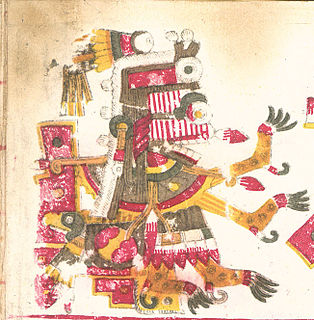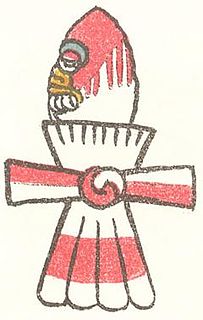
Aztec mythology is the body or collection of myths of the Aztec civilization of Central Mexico. The Aztecs were Nahuatl-speaking groups living in central Mexico and much of their mythology is similar to that of other Mesoamerican cultures. According to legend, the various groups who were to become the Aztecs arrived from the north into the Anahuac valley around Lake Texcoco. The location of this valley and lake of destination is clear – it is the heart of modern Mexico City – but little can be known with certainty about the origin of the Aztec. There are different accounts of their origin. In the myth the ancestors of the Mexica/Aztec came from a place in the north called Aztlan, the last of seven nahuatlacas to make the journey southward, hence their name "Azteca." Other accounts cite their origin in Chicomoztoc, "the place of the seven caves," or at Tamoanchan.

Tezcatlipoca was a central deity in Aztec religion, and his main festival was the Toxcatl ceremony celebrated in the month of May. One of the four sons of Ometecuhtli and Omecihuatl. The God of providence, he is associated with a wide range of concepts, including the night sky, the night winds, hurricanes, the north, the earth, obsidian, hostility, discord, rulership, divination, temptation, jaguars, sorcery, beauty, war, and conflict. His name in the Nahuatl language is often translated as "Smoking Mirror" and alludes to his connection to obsidian, the material from which mirrors were made in Mesoamerica and which were used for shamanic rituals and prophecy. Another talisman related to Tezcatlipoca was a disc worn as a chest pectoral. This talisman was carved out of abalone shell and depicted on the chest of both Huitzilopochtli and Tezcatlipoca in codex illustrations.

Mictlan is the underworld of Aztec mythology. Most people who die would travel to Mictlan, although other possibilities exist.. Mictlan consists of nine distinct levels.

In Aztec mythology, Xolotl was a god of fire and lightning. He was commonly depicted as a dog-headed man and was a soul-guide for the dead. He was also god of twins, monsters, misfortune, sickness, and deformities. Xolotl is the canine brother and twin of Quetzalcoatl, the pair being sons of the virgin Chimalma. He is the dark personification of Venus, the evening star, and was associated with heavenly fire. The Axolotl is named after him. A lot of his attributes are similar to Yama in Indian and Persian mythology.

In Aztec mythology, Huitzilopochtli is the deity of war, sun, human sacrifice, and the patron of the city of Tenochtitlan. He was also the tribal god of the Mexicas, also known as the Aztecs, of Tenochtitlan. Many in the pantheon of deities of the Aztecs were inclined to have a fondness for a particular aspect of warfare. However, Huitzilopochtli was known as the primary god of war in ancient Mexico. Since he was the patron god of the Mexica, he was credited with both the victories and defeats that the Mexica people had on the battlefield. The people had to make sacrifices to him to protect the Aztec from infinite night. He wielded Xiuhcoatl, the fire serpent, as a weapon, thus also associating Huitzilopochtli with fire.

Mictlāntēcutli or Mictlantecuhtli, in Aztec mythology, is a god of the dead and the king of Mictlan (Chicunauhmictlan), the lowest and northernmost section of the underworld. He is one of the principal gods of the Aztecs and is the most prominent of several gods and goddesses of death and the underworld. The worship of Mictlantecuhtli sometimes involved ritual cannibalism, with human flesh being consumed in and around the temple. Other names given to Mictlantecuhtli include Ixpuztec, Nextepehua, and Tzontemoc.

Mixcoatl, or Camaztle[kaˈmaʃt͡ɬe] from camaz "deer sandal" and atle "without", or Camaxtli, was the god of the hunt and identified with the Milky Way, the stars, and the heavens in several Mesoamerican cultures. He was the patron deity of the Otomi, the Chichimecs, and several groups that claimed descent from the Chichimecs. Under the name of Camaxtli, Mixcoatl was worshipped as the central deity of Huejotzingo and Tlaxcala.

In Aztec mythology, the god Nanahuatzin or Nanahuatl, the most humble of the gods, sacrificed himself in fire so that he would continue to shine on Earth as the Sun, thus becoming the sun god. Nanahuatzin means "full of sores." According to a translation of the Histoyre du Mechique, Nanahuatzin is the son of Itzpapalotl and Cuzcamiahu or Tonan, but was adopted by Piltzintecuhtli and Xōchiquetzal. In the Codex Borgia, Nanahuatzin is represented as a man emerging from a fire. This was originally interpreted as an illustration of cannibalism. He is probably an aspect of Xolotl.

Tlaltecuhtli is a pre-Columbian Mesoamerican deity worshipped primarily by the Mexica (Aztec) people. Sometimes referred to as the "earth monster," Tlaltecuhtli's dismembered body was the basis for the world in the Aztec creation story of the fifth and final cosmos. In carvings, Tlaltecuhtli is often depicted as an anthropomorphic being with splayed arms and legs. Considered the source of all living things, she had to be kept sated by human sacrifices which would ensure the continued order of the world.

In Aztec mythology and religion, Xipe Totec or Xipetotec was a life-death-rebirth deity, god of agriculture, vegetation, the east, spring, goldsmiths, silversmiths, liberation, and the seasons. Xipe Totec was also known by various other names, including Tlatlauhca, Tlatlauhqui Tezcatlipoca and Yohuallahuan, and Yaotzin. The Tlaxcaltecs and the Huexotzincas worshipped a version of the deity under the name of Camaxtli, and the god has been identified with Yopi, a Zapotec god represented on Classic Period urns. The female equivalent of Xipe Totec was the goddess Xilonen-Chicomecoatl.

In Aztec religion, Ītzpāpālōtl[iːt͡spaːˈpaːlot͡ɬ] was a striking skeletal warrior goddess who ruled over the paradise world of Tamoanchan, the paradise of victims of infant mortality and the place identified as where humans were created. She is the mother of Mixcoatl and is particularly associated with the moth Rothschildia orizaba from the family Saturniidae. Some of her associations are birds and fire. However, she primarily appears in the form of the Obsidian Butterfly.
In Aztec mythology, the Centzonmīmixcōah are the gods of the northern stars. They are sons of Camaxtle-Mixcoatl with the Earth Goddess, according to the Codex Ramírez, or Tonatiuh with Chalchiuhtlicue, the goddess of the seas.
In the context of creation myths, the term Five Suns describes the doctrine of the Aztec and other Nahua peoples in which the present world was preceded by four other cycles of creation and destruction. It is primarily derived from the mythological, cosmological and eschatological beliefs and traditions of earlier cultures from central Mexico and the Mesoamerican region in general. The Late Postclassic Aztec society inherited many traditions concerning Mesoamerican creation accounts, while modifying some aspects and supplying novel interpretations of their own.

The Aztec religion originated from the indigenous Aztecs of central Mexico. Like other Mesoamerican religions, it also has practices such as human sacrifice in connection with many religious festivals which are in the Aztec calendar. This polytheistic religion has many gods and goddesses; the Aztecs would often incorporate deities that were borrowed from other geographic regions and peoples into their own religious practices.

Quetzalcoatl is a deity in Aztec culture and literature whose name comes from the Nahuatl language and means "Precious serpent" or "Quetzal-feathered Serpent". In the 17th century, Ixtlilxóchitl, a descendant of Aztec royalty and historian of the Nahua people, wrote, "Quetzalcoatl, in its literal sense, means 'serpent of precious feathers', but in the allegorical sense, 'wisest of men'."

In Aztec mythology, Creator-gods are the only four Tezcatlipocas, the children of the creator couple Ometecuhtli and Omecihuatl "Lord and Lady of Duality", "Lord and Lady of the Near and the Close", "Father and Mother of the Gods", "Father and Mother of us all", who received the gift of the ability to create other living beings without childbearing. They reside atop a mythical thirteenth heaven Ilhuicatl-Omeyocan "the place of duality".
In Aztec mythology the Lords of the Day are a set of thirteen gods that ruled over a particular day corresponding to one of the thirteen heavens. They were cyclical, so that the same god recurred every thirteen days. In the Aztec calendar, the lords of the day are
- Xiuhtecuhtli, god of fire and time.
- Tlaltecuhtli, god of the earth.
- Chalchiuhtlicue, goddess of water, lakes, rivers, seas, streams, horizontal waters, storms and baptism.
- Tonatiuh, god of the sun.
- Tlazolteotl, goddess of lust, carnality, sexual misdeeds.
- Mictlantecuhtli, god of the underworld.
- Centeotl, goddess of maize. Also recognized as Chicomecoatl, goddess of agriculture.
- Tlaloc, god of the thunder, rain and earthquakes.
- Quetzalcoatl, god of wisdom, life, knowledge, morning star, fertility, patron of the winds and the light, the lord of the West.
- Tezcatlipoca, god of providence, matter and the invisible, ruler of the night, Great Bear, impalpable, ubiquity and the twilight, the lord of the North.
- Mictecacihuatl, goddess of the underworld.
- Tlahuizcalpantecuhtli, god of dawn.
- Citlalicue, goddess of the female stars.

In the Aztec culture, a tecpatl was a flint or obsidian knife with a lanceolate figure and double-edged blade, with elongated ends. Both ends could be rounded or pointed, but other designs were made with a blade attached to a handle. It can be represented with the top half red, reminiscent of the color of blood, in representations of human sacrifice and the rest white, indicating the color of the flint blade.

Onyx Equinox is an American adult animated streaming television series created by Sofia Alexander for Crunchyroll. It is based on the mythologies of Mesoamerica, featuring deities of Aztec, Maya and Zapotec myth, while also making references to the Olmecs.














